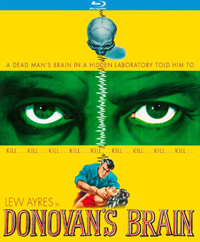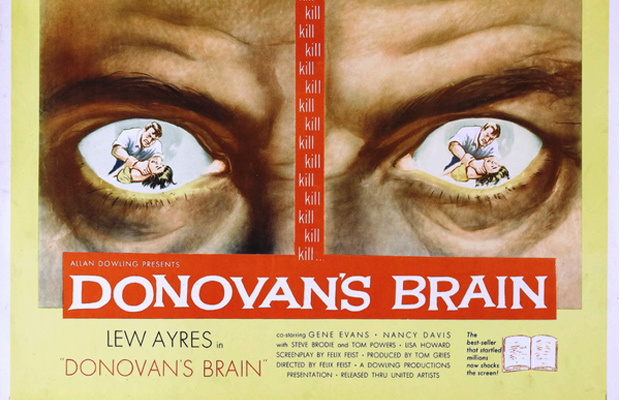
Dr. Patrick Corey (Lew Ayres) is experimenting on brains out of his lab from the privacy of his country home. Assisted by Dr. Frank Schratt (Gene Evans) and his complacent wife Janice (Nancy Regan), Corey dismembers monkeys and examines their brain waves after the organ is removed from the body. When a plane crashes right outside their home, a dying millionaire named W.H. Donovan is rushed into his lab, but he dies before resuscitation. Corey has the idea to steal his brain and use it for his experiments since the man obviously no longer needs it. However, Donovan’s brain begins to take telepathic control of the morally ambiguous doctor, while a nosy reporter (Steve Brodie) begins to suspect Corey’s actions.
What’s particularly notable about this 1953 treatment (beyond it being the only version to actually utilize the name of the novel) is several cast members of note and the title’s position in their filmography. Lew Ayres had recently scored an Oscar nod in 1948 for Johnny Belinda (his only one), but following this the actor would complete the rest of the decade in television, returning to film once again nearly a decade late in Otto Preminger’s provocative 1962 film Advise & Consent (a vehicle also meant to revitalize fallen star Gene Tierney). Likewise, co-star Nancy Davis would complete a handful of television appearances and two more films before marrying Ronald Reagan, ending her career as an actress in 1962.
As directed by Felix E. Feist, a director probably best remembered for B noir titles such as 1950’s The Man Who Cheated Himself (thanks to its falling into the public domain) and the infamous 1952 Joan Crawford vehicle This Woman is Dangerous (the final straw in the star’s struggle to claw her way out of Warner Bros.), Donovan’s Brain is crushingly elementary.
Ayres, in particular, seems rather bored with a scenario where he could’ve channeled a Jekyll and Hyde dynamic. He isn’t helped much by an incredibly dowdy Nancy Reagan, forced into a catch-all stereotype of 1950s housewife subservience. Early on, she questions her husband’s ethics of using monkey brains for his experiments. After demeaning her intelligence he advises her to go make one of her ‘wonderful stews.’ And yet, she serves as maid, cook, and part-time lab assistant, while his alcoholic lab assistant (a ruddy Gene Evans) is never held to task for his irresponsibility. Beyond its acting deficiencies, set design also seems an after-thought. Since the brain isn’t an amphibious creature, why no one addresses how it isn’t drying out as it hovers above a pool of milky water in a tank is peculiar, not to mention how unappealing such a set-up would smell.
Wildly uneven, Siodmak’s basic treatment fostered a number of copycat B movies, from the loosely oriented The Thing That Couldn’t Die (1958) to The Brain That Wouldn’t Die (1968) to The Incredible 2-Headed Transplant (1971) which headlines Bruce Dern and borrows the main set-up Donovan’s Brain (a mad scientist, a weird assistant, and an ignored wife involved in a creepy experiment where they accidentally acquire the necessary means for their nonsensical endeavor). Despite several bits of salty dialogue (“money can’t help him now,” the phsyicians remark on the dying millionaire as he extinguishes on their operating table), the viewing experience would be greatly enhanced by a comedic commentary track.
Disc Review:
Newly remastered in HD, this Kino Lorber Studio Classic’s release looks great in this 1.37:1 presentation, which, considering the period does feature a fair share of wondrous special effects, including a pulsing brain and a cute little monkey shortly before being butchered (off-screen) for its brain. Notably, Joseph F. Biroc served as DP (famous for It’s a Wonderful Life and an Oscar winner for The Towering Inferno), who had an interesting filmography of genre (Hush, Hush, Sweet Charlotte) and slapstick Airplane!). Optional audio commentary from film historian Richard Harland Smith is available, as well as a segment from Joe Dante’s “Trailers from Hell.”
Final Thoughts:
Silly without ever being very effective, what’s most interesting about Siodmak’s initial text is the far-reaching cinematic influence over schlocky B-grade sci-fi it would have, to the extent these tropes are now taken-for-granted clichés. There’s enough to warrant a look of this 1953 version of Donovan’s Brain, though mostly thanks to its curious cast.
Film Review: ★★/☆☆☆☆☆
Disc Review: ★★★/☆☆☆☆☆
